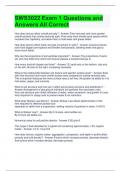SWS3022 Exam 1 Questions and
Answers All Correct
How does texture affect overall porosity? - Answer-Finer-textured soils have greater
overall porosity than coarse-textured soils. Finer soils have smaller pore spaces which
increase their capillarity, and allow them to hold water and gases better.
How does texture affect water and gas movement in soils? - Answer-Coarse-textured
soils have bigger pore spaces and smaller total porosity, allowing water and gas to
move much faster.
Why are the proportions of soil particles important? - Answer-The proportions of sand,
silt, and clay determine which soil textural classes a sample belongs to.
How many textural classes are there? - Answer-12; sand axis on the bottom, clay axis
on the left, silt axis on the right, increasing clockwise
What is the relationship between soil texture and specific surface area? - Answer-Soils
with finer textures have more overall surface area compared to coarse-textured soils.
This is important because the more surface area a soil has, the greater its ability for it to
hold water, gases, and nutrients.
What is soil structure and how can it affect soil porosity and pore size distribution? -
Answer-Arrangement of grouping of individual soil particles into secondary units.
Poor soil structure can inhibit infiltration of water, water movement, and growth of roots.
Very important in clayey soils to prevent water & air restriction.
What does Stokes' Law define? - Answer-Stokes' Law allows determination of the
time required for different particle size
separates to settle from a suspension; settling velocity of particles in water; V=KD^2
What is Stokes' Law? - Answer-By 2 minutes, sand settles out
By 6 hours silt settles out
Numerical value for soil particle density - Answer-2.65 g/cm3
The range in bulk densities for a typical soil containing approximately 1-5% organic
matter - Answer-1.0 to 1.6 g/cm3
How does texture, organic matter, aggregation, compaction, and depth in profile affect
porosity and bulk density? - Answer-Factors which increase porosity, decrease density.
And factors which increase density, decrease porosity
, Dimensions of the Earth - Answer-Diameter: 8000 mi
Circumference: 25,000 mi
What do the definitions of soil depend on? - Answer-The definition of soil is dynamic
because many specializations and disciplines view soil differently: ecological,
geological, environmental, etc.
Parameters related to soil composition for an idealized surface soil - Answer-50% pore
space and 45% particles, 5% OM
Basic functions of soils in the environment - Answer-Medium for plant growth: support,
gas and water exchange, temperature control, nutrient storage and release.
Regulator for water supplies: infiltration, runoff, storage, movement, purification.
The 4 basic processes involved in soil formation - Answer-Additions, losses,
transformations, translocations
Basics of weathering - Answer-Critical to Soil Formation, Physical and Chemical
Alteration and Reorganization of Rocks and Minerals. Critical in the Creation of the
Parent Material and
Alteration of Parent Material to Secondary Components.
5 soil forming factors - Answer-Parent material, climate, organisms, relief (topography),
and time
Type of parent material that dominates Florida's soils - Answer-Loamy marine
sediments; Sandy and clayey marine and alluvial (deposited by rivers and streams)
deposited over limestone bedrock; Mostly calcium and magnesium carbonates from
original ocean species like corals and mollusks
What is the origin of the sediments that ultimately formed the parent materials for
Florida soils? - Answer-An influx of continental sediments began about 25 mya; the
sediments were shed from the Appalachian mountains by the lowering sea levels
How do rainfall and temperature impact soil formation? - Answer-Increased temperature
and rainfall both accelerate soil formation.
High temperatures increase the rate of physiological processes (microbial activity,
organisms) while water increases the rate of weathering and translocation, ultimately
increasing the rate of transformation.
Why are soils in Florida more developed compared to soils in the west? - Answer-In the
east there is more rainfall, causing faster weathering and soil transformation. This
causes more differentiated soil horizons.




